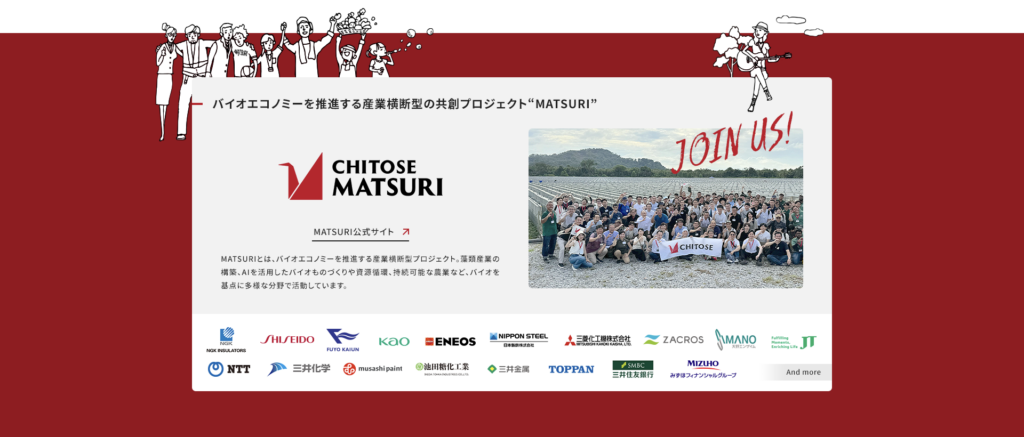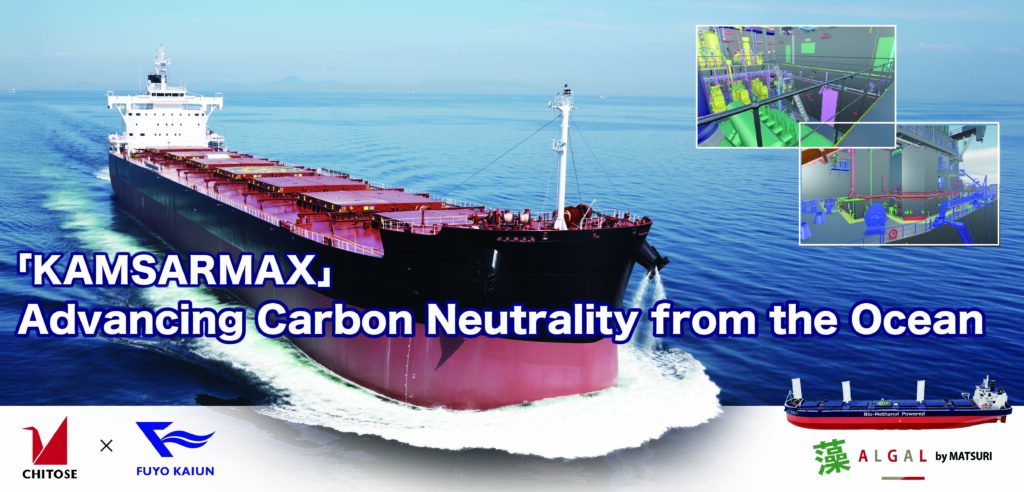
What comes to mind when you hear “algae”? A green layer in a pond, or seaweeds like kelp and wakame?
Now, algae are drawing attention as materials that could support future lifestyles. At Expo 2025 Osaka, Kansai, the Japan Pavilion features algae as one of its key themes. CHITOSE’s cross-industry initiative, MATSURI, is showcasing “ALGAL by MATSURI” — a window into the future, filled with fashion, cosmetics, food, and paints made from algae.

In the lower right corner of the display window sits an impressively detailed model ship—a scaled replica of the real-life bulk carrier KAMSARMAX.
These vessels are under construction by TSUNEISHI SHIPBUILDING Co., Ltd. (hereinafter, TSUNEISHI SHIPBUILDING), a name Japan proudly shares to the world. Based in Fukuyama, Hiroshima, the company is recognized globally for its shipbuilding expertise. Helping bring KAMSARMAX to the Japan Pavilion exhibit was Fuyo Kaiun Co.,Ltd (hereinafter, Fuyo Kaiun), a global maritime company specializing in ship leasing and operational management.
We spoke with Kazutaka Seki from TSUNEISHI SHIPBUILDING, who was involved in the ship’s design, and Yusuke Kubo, the driving force behind the exhibit and representative of Mers Line Pte. Ltd. (hereinafter, Mers Line), part of the Fuyo Kaiun Group. Together, they shared insights into the hidden world of this massive seafaring vessel, and the beauty embedded in its design.
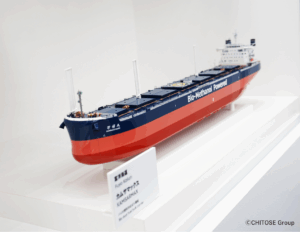
Featured in This Interview
Yusuke Kubo
― President, Mers Line
Kazutaka Seki
― General Manager, Ship Planning Dept. Design Div., TSUNEISHI SHIPBUILDING
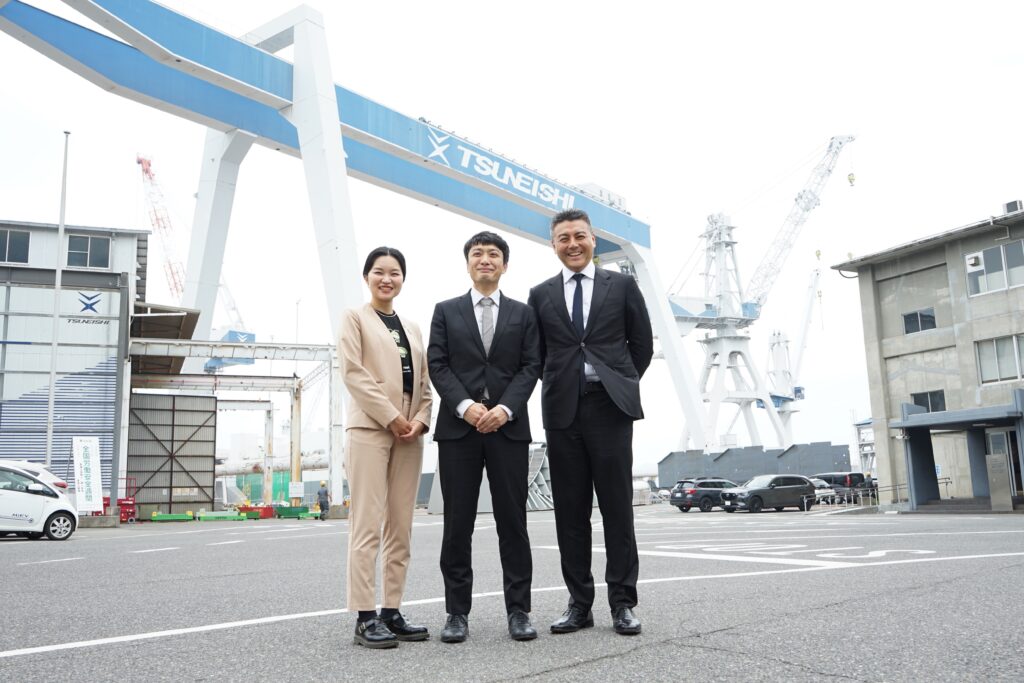
Glossary of Terms
■ KAMSARMAX
A bulk carrier developed by TSUNEISHI SHIPBUILDING, designed to dock at Port Kamsar in Guinea, West Africa. Measuring 229 meters in length with a maximum loading capacity of 82,000 tons (equivalent to 1.5 billion bowls of rice – that’s enough to feed a class of 30 students three meals a day for about 50,000 years!), this vessel transports cargo like grain and iron ore around the world. It is also one of the benchmark vessel types included in the Baltic Dry Index, a key indicator of global shipping market trends.
■ Dual-fuel
An engine system capable of running on two types of fuel. Instead of relying on a single source, such as heavy oil alone, it can switch between fuels like heavy oil and methanol depending on the circumstances. This flexibility allows for the use of cleaner, lower-emission fuels, making dual-fuel technology a key transitional step toward decarbonization. The KAMSARMAX model on display at the Japan Pavilion represents the latest dual-fuelled ship design, powered by algae-derived marine fuel.
Bringing Japan’s Excellence to the Japan Pavilion
— First, Mr. Kubo, what made you want to showcase this vessel at the Japan Pavilion at Expo 2025?
Mr. Kubo – Mers Line:
When you have an opportunity like the Expo, and especially to exhibit at the Japan Pavilion, you want to present something you can proudly call the best in the world. Japan’s shipbuilding technology is world’s top level, and among many “world’s best” achievements, the first that came to mind was TSUNEISHI SHIPBUILDING’s KAMSARMAX.
I still clearly remember the surprise back around 2010, when this ship was adopted as the standard vessel type for the Baltic Dry Index, the global benchmark for bulk shipping rates. Being chosen as the “standard vessel type” is proof that the ship’s design, popularity, and performance have been internationally recognized. In other words, global market analysis and investment decisions are heavily influenced by KAMSARMAX’s freight rates. That’s truly thrilling!
So, naturally, I wanted the Japan Pavilion to feature something world-class made in Japan. Now that this has come true, I feel proud of the work we’ve accomplished, and I’m deeply grateful to TSUNEISHI SHIPBUILDING for making it possible.
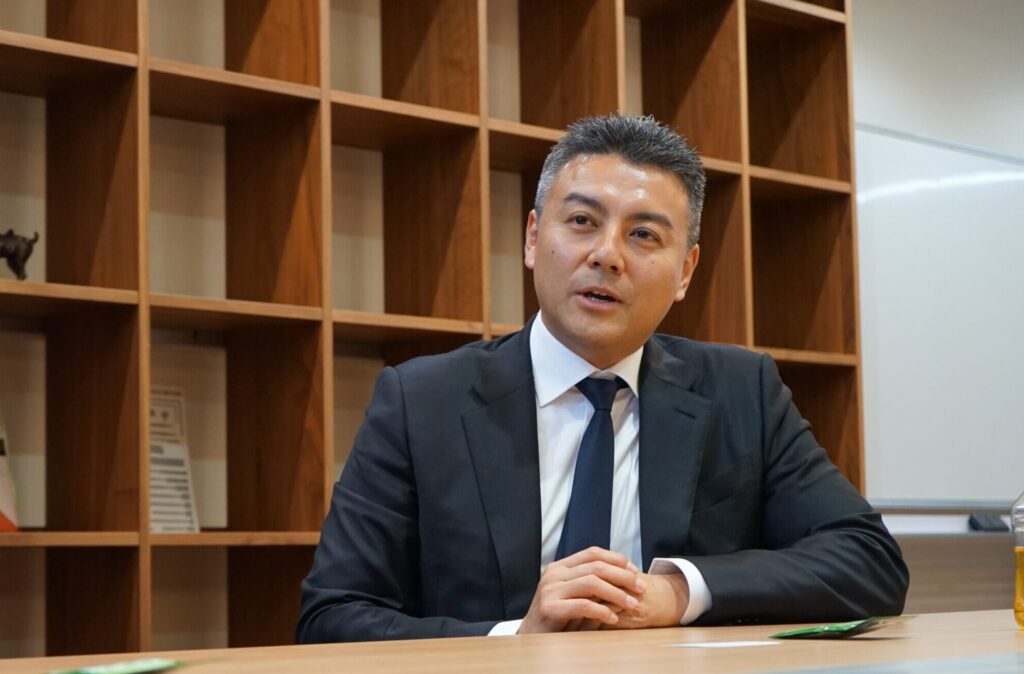
— Mr. Seki, we understand that your work involves ship design. What specific parts of the process are you responsible for?
Mr. Seki – TSUNEISHI SHIPBUILDING:
I’m primarily responsible for the earliest stage of the ship design process, starting with the concept development. For example, I begin by asking, “What should the next KAMSARMAX be like?” From there, I define the overall framework, including the length of the vessel, draft (the depth of the submerged portion), cargo capacity, and fuel efficiency.
Of course, this is all based on the theories and designs developed by our predecessors, but our job is to continuously improve performance. For example, the latest KAMSARMAX model, which the display vessel is based on, features a shape optimized to reduce air resistance, improving overall fuel efficiency by several percent.
— It sounds like your job requires both creative sense and strong mathematical skills. By the way, what was your favorite subject when you were a child? Probably math?
Mr. Seki – TSUNEISHI SHIPBUILDING:
(Laughs) I’d say… I really liked arts and crafts!
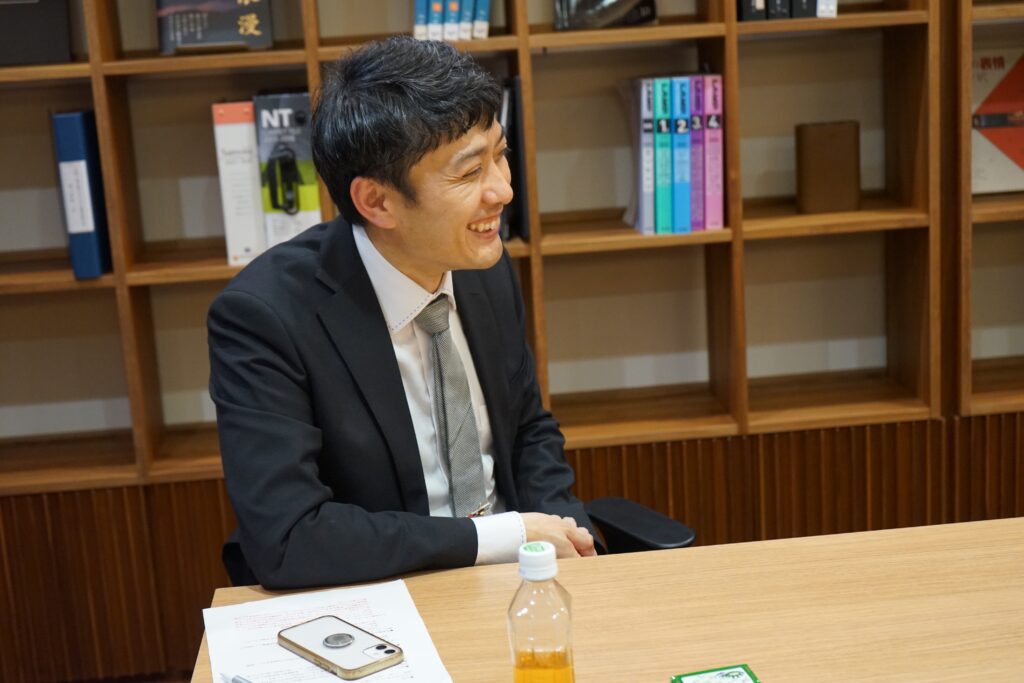
What Gives a Vessel Its Value?
— There must be many factors that determine a ship’s value, but is fuel efficiency one of the biggest?
Mr. Kubo – Mers Line:
Absolutely. Ships operate over long periods of time, so even a few percent in fuel efficiency adds up to a massive impact over the vessel’s lifetime. In fact, when you compare vessel designs from about 10 years ago to the latest models, there’s roughly a 30% efficiency improvement. Using 30% less fuel to carry the same cargo is a game-changer in terms of cost.
Flexibility to access a wide range of ports is also a major factor. For example, if you widen the hull to maintain the same cargo capacity, the draft becomes shallower, which means the vessel can enter more ports. But at the same time, it reduces the number of waterways it can pass through. On the flip side, if you narrow the hull to access more routes, the draft becomes deeper, which limits the number of ports you can call at.
KAMSARMAX strikes a precise balance within these kinds of constraints. That’s what makes it compatible with ports around the world. KAMSARMAX is highly regarded not just for its “cool” design, but also for its practicality and performance.
Mr. Seki – TSUNEISHI SHIPBUILDING:
When it comes to the ship’s sleek appearance, I’d say it’s a kind of functional beauty – a result of pursuing fuel efficiency. For example, the curved bow reduces resistance even in high waves, the living quarters are shaped with softened edges rather than a simple boxy form to minimize wind drag, and the overall silhouette is streamlined to deflect both air and water resistance as much as possible. Every element serves a purpose. At TSUNEISHI, we don’t want our vessels to be seen as “efficient but unattractive,” we aim for “high-performance and great-looking” vessels.
Mr. Kubo – Mers Line:
Every detail is calculated with precision. It’s really amazing!
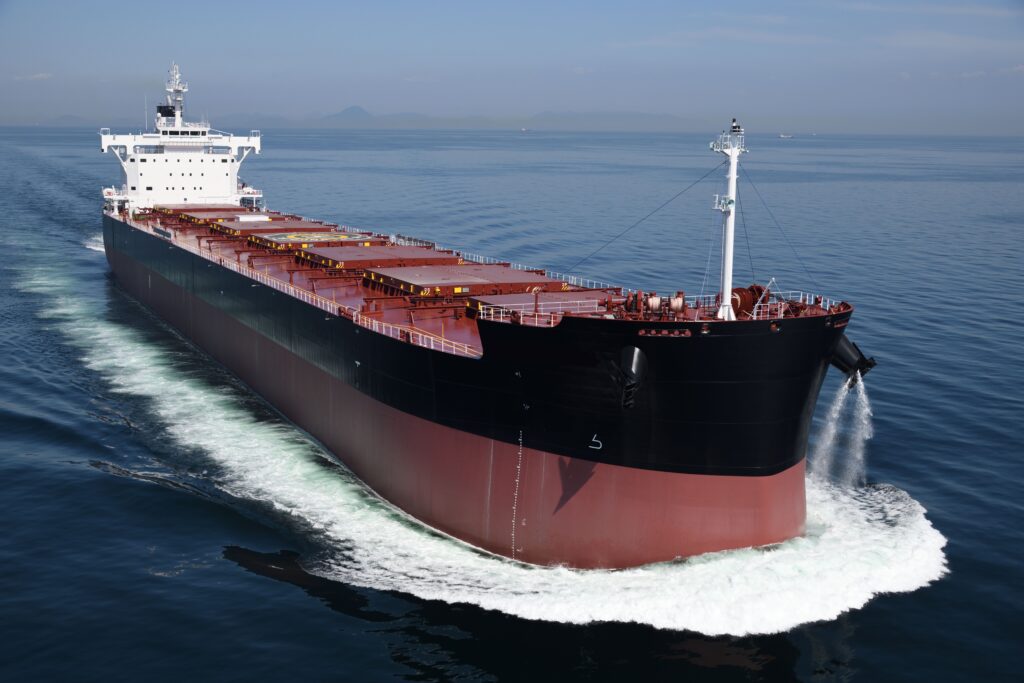
Mr. Seki – TSUNEISHI SHIPBUILDING:
I’m glad to hear that! With KAMSARMAX, we were meticulous not only in functionality but also in the design of the crew’s living quarters. We raised the ceiling height by about 20 cm compared to typical vessels, and incorporated wooden furniture and indirect lighting. We’ve also worked to minimize engine vibrations to ensure the crew can spend long voyages as comfortably as possible.
Mr. Kubo – Mers Line:
The comfort of the crew is actually a very important factor. Good vessels attract good crew members, who in turn tend to take good care of the vessel and stay with it for the long term. This improves operational efficiency and also increases the vessel’s second-hand value. It’s a crucial aspect that directly impacts the asset value of a vessel.
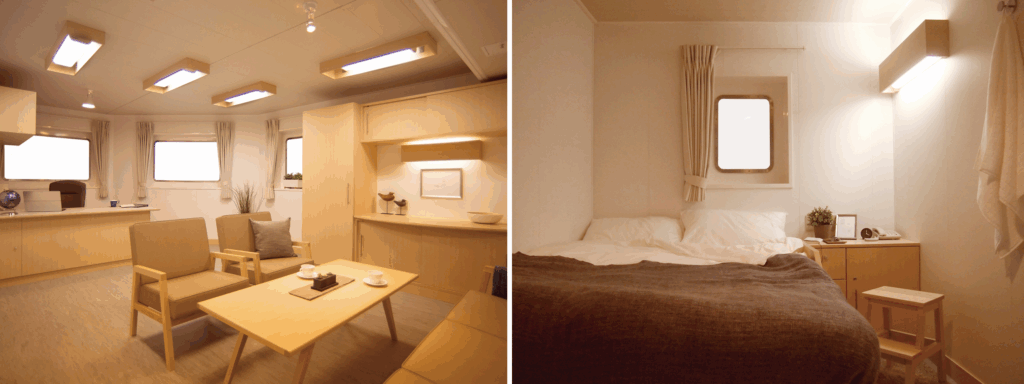
0.01mm Algae Powering 229 Meters of Steel?
— Vessels traditionally run on heavy fuel oil. More recently, dual-fuel vessels have emerged, capable of running on combinations like heavy oil and hydrogen, or heavy oil and methanol. Is there really any room for algae-derived fuels?
Mr. Kubo – Mers Line:
TSUNEISHI SHIPBUILDING has already developed vessels powered not just by heavy fuel oil, but also by LNG (liquefied natural gas), hydrogen, and methanol. Certain types of algae can produce oils similar to petroleum, so from a technological standpoint, it’s possible to generate a variety of fuels from algae. However, when it comes to using algae as a marine fuel, the big hurdles are cost and supply volume. No matter how promising the fuel is, if it can’t be supplied reliably and affordably at the time it’s needed, it won’t work in the shipping industry.
— That’s exactly the challenge we’re working to solve. Since 2018, CHITOSE has been operating a 1,000 m² algae production facility in Malaysia, and we currently have a 5-hectare facility in operation. We’re now preparing to scale that up to 100 hectares, with plans to reach 2,000 hectares by around 2030. And we’re aiming to go even further beyond that. It’s said that if we created algae farms across an area equal to the world’s current cornfields, we could produce enough oil to meet half of humanity’s fuel needs.
By the way, the algae species that produces an oil similar to petroleum is called Botryococcus, and we cultivate it at CHITOSE. It burns extremely well! In fact, a few years ago we dried some and used it as barbecue fuel. It burned a bit too well – the meat ended up completely charred! (laughs)

Mr. Kubo – Mers Line:
We should note that algae aren’t just about oil – you can extract other valuable components from the leftover biomass after oil is pressed out. Take Botryococcus, for example. While it’s not currently approved for human consumption, it has strong potential as feed for livestock and other animals. And there are other species, like Spirulina and Chlorella, that are already known for their high nutritional value and are used as food. I believe algae could eventually become a viable alternative to grains – a key for global food security.
You extract the oil, then repurpose the leftover biomass as food. The ability to use 100% of the algae is what makes it so fascinating, and it’s also where we see opportunity. Taking this potential and turning it into real-world industries is exactly what CHITOSE is doing at MATSURI. It’s an ambitious initiative that’s bringing together manufacturers and companies from a wide range of sectors to pool their technologies and expertise, developing new algae-based products. We at Fuyo Kaiun are proud to be a part of that effort.
Carbon Neutrality by 2050 is Closer Than It Seems
— The phrase “carbon neutral by 2050” is becoming common across many industries. 2050 is still 25 years away, and, frankly, it is quite hard to envision the future. In ship design, how do you incorporate such a long-term goal into your concepts and day-to-day work?
Mr. Seki – TSUNEISHI SHIPBUILDING:
You’re right, it’s currently difficult to clearly envision what 2050 will look like. But what we can do right now is expand the range of options available. For example, the latest KAMSARMAX can be adapted to multiple fuel types, such as methanol, LNG, ammonia, hydrogen, and more. If, in the future, any of the biofuels becomes reliably available, the ship will be ready to operate with zero emissions. Compared to a ship that only runs on heavy fuel oil, we’re giving ourselves twice the number of pathways to achieve zero emissions. Our development approach is very much about preparing for an uncertain future.
Mr. Kubo – Mers Line:
Also, the typical lifespan of a ship is around 20 to 30 years. That means ships operating in 2050 are already being designed, and in some cases, built today. So 2050 isn’t really that far off.
— Earlier, we touched on the cost and supply challenges of using algae as marine fuel. On the other hand, achieving carbon neutrality is becoming increasingly urgent. How do you approach the balance between economic viability and environmental responsibility?
Mr. Seki – TSUNEISHI SHIPBUILDING:
Efforts to reduce environmental impact aren’t necessarily at odds with economic viability. For instance, designing ships to be dual-fuel capable allows us to adapt flexibly to uncertain future fuel availability. Yes, the initial investment is higher, but by building ships with versatility in mind, we can offer more cost-competitive solutions in the long run.
In fact, if we assume a future where carbon emissions are taxed or regulated more strictly, investing upfront may prove to be the more economical path over the full life cycle of the vessel.
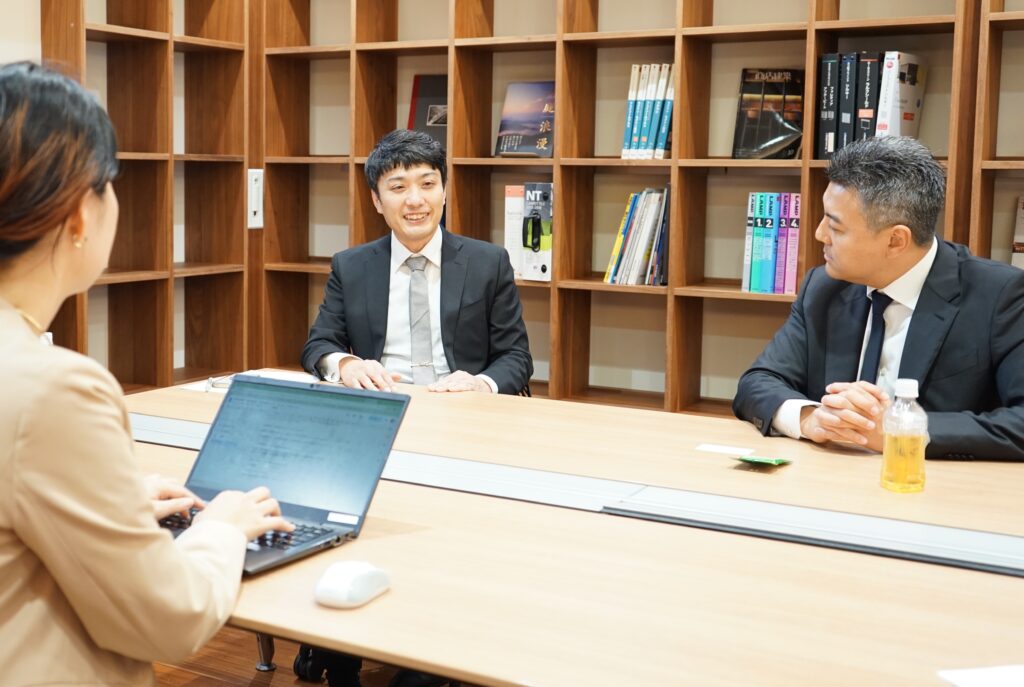
— What do you hope people will feel when they see the KAMSARMAX model ship at the Japan Pavilion?
Mr. Seki – TSUNEISHI SHIPBUILDING:
Personally, I’d be happy if visitors thought, “Wow, that’s cool,” or started to imagine how a ship like this carries grain across the world.
For most people, it’s not uncommon to see fishing boats or yachts, but it’s rare to encounter an ocean-going commercial vessel like KAMSARMAX up close. And this particular model represents a “ship of the future,” designed with long-term sustainability and performance in mind. That’s why I believe there’s real value in having people interact with it at the Japan Pavilion, even as a model, and understand that this kind of vessel plays a crucial role in supporting global logistics.
— After touring the shipyard today, we could really see how much technology, expertise, and human passion go into designing and operating these ships. Hopefully, it will spark interest not only in KAMSARMAX itself, but also in the broader maritime industry.
Mr. Seki – TSUNEISHI SHIPBUILDING:
That’s right. The maritime industry is primarily B2B (business-to-business) so it tends to be out of sight for the general public. But in reality, it’s a field where human connections are absolutely vital.
Right now, I feel we’re in the midst of a once-in-a-century transformation, as the industry moves toward carbon neutrality. To be working in this sector during such a pivotal time makes me really happy.
Precisely because this moment is so challenging, there’s a limit to what any single company can do on its own. That’s why it’s so important to collaborate with partners like CHITOSE, who are from outside the traditional boundaries of our industry. Together, we can unlock entirely new possibilities.
In solving challenges with others, we ourselves become the kind of company others want to team up with. That’s one of the most rewarding aspects of working in this industry. If KAMSARMAX on display at the Japan Pavilion can serve as a gateway, if it inspires the next generation of young people to step into this world and take on its challenges, there would be nothing more gratifying.
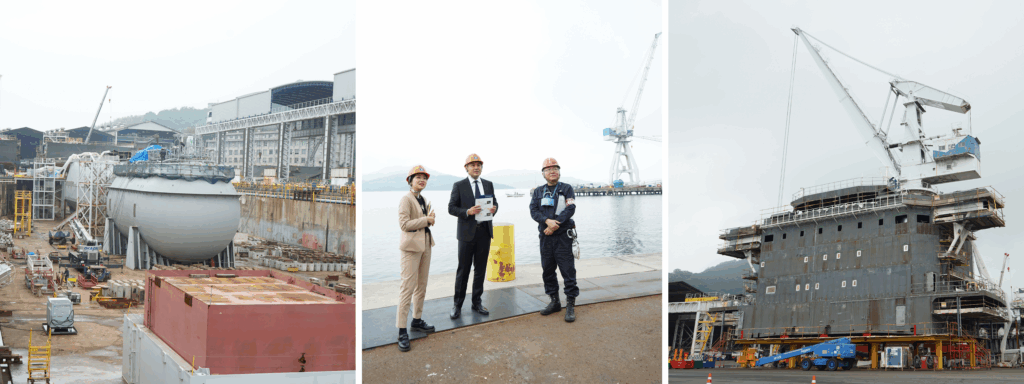
— In the Age of Discovery, merchant ships ventured into uncharted waters, carrying spices, treasures, and the dreams of many. Today, KAMSARMAX follows in that same lineage, now setting sail toward a new course: carbon neutrality. The ship you’ll encounter at the Japan Pavilion is more than just a model. What kind of future might it steer us toward?
Written by Natsuho Konno / Translated by Tanya Topolian